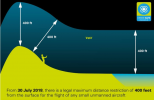Hmm. That page could maybe do with some clarification as it seems to contradict itself. Firstly, the CAA states this:
That's pretty imperative, given it's a major heading and is accompanied by the image that only shows 120m measured vertically and directly below the aircraft. But then, immediately after that, is the sub-section you quoted above; "from the closest point", which it then re-iterates with:
However, going back to the original drawing, the two marked points are over level terrain to the side of the hill and directly over the summit, e.g. the closest point to the terrain is a straight vertical of 120m - there isn't a 120m indication provided for the slope of the hill! Taking all that together, I think it's intended as a general case - 120m AGL - with a specific exception for hills, mountains, and cliffs where the 120m can be measured as the distance from the closest point on the ground in any direction.












